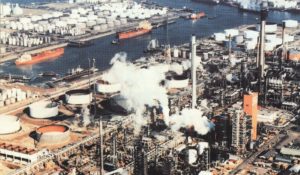
The shipping industry is the anchor of global trade, carrying about 90% of goods. As the world’s energy system shifts to cleaner fuels, the IMO expects its cut in marine fuel sulfur limits to have a significant beneficial impact on the environment and on human health. IMO has been working to reduce harmful impacts of shipping on the environment since the 1960s. Today the International Maritime Organization (IMO) is moving forward with a marked reduction from 3.5% to 0.5% in the maximum sulfur content of marine fuel (bunker fuel oil) on January 1, 2020.
What does that mean for marine and refinery industries? Ship owners will need to decide if they want to continue using high Sulphur fuel oil, in conjunction with exhaust gas cleaning scrubbers or switch to low Sulphur fuel options, including distillates and LNG fuel. Their decisions will cause a dramatic shift in the demand of marine fuels used globally and will have an immediate impact on global refining.
Time is the enemy of both shippers and refineries. Unless refinery modifications to reduce HSFO production are already well underway, those modifications will not be on stream until well after 2020. A recent survey of ship owners by Drewry reveals that two-thirds of shippers are preparing to bunker their ships with more expensive low Sulphur fuel oil (LSFO) when the IMO’s 0.5% Sulphur cap is introduced in January 2020. 66% of respondents told that LSFO was the intended solution for their vessels, whereas only 13% were intending to retro fit scrubbers to their ships and just 8% were considering LNG as an option. A recent report by Swedish SEB estimated that fewer than 2,000 ships would have scrubber systems installed by the 2020 deadline out of a total merchant fleet of some 60,000 vessels. Taking into account the number of existing scrubber manufacturers and their production capabilities, there must be a deficit in scrubbers availability in the next few years, which will increase financial challenges and consequently LSFO prices.
Current total marine bunker fuel consumption (Fuel Oil, MGO, MDO and other low Sulphur distillates) is about 5.3 million b/d. By 2020 the total marine bunker fuels demand is set to reach 5.8 million b/d. Refineries will then be required to increase low Sulphur distillate output by 2.1 million b/d and low Sulphur resid fuel output by about 0.9 million b/d. Ideally the 3.5 million b/d of current high Sulphur resid fuel (3.5% sulphur) output should be cracked and desulphurized in the refineries as only 0.9 million b/d of high Sulphur resid fuels will be needed in 2020.
There are only 16 months between now and January 1, 2020 when the IMO 2020 Rule takes effect, too short of time to initiate a residual upgrading project, which may remain options for the long term. Without the opportunity to respond with an investment timed to be on stream in 2020, refiners and shippers will have to find immediate solutions to reduce their exposure to the marine HSFO market.
Among the low-capex and short-term solutions proposed by Modcon Systems, which can be realistically implemented by refineries before 2020 are the following:
- Installing latest-generation reactor internals and catalysts, which can enable the hydrotreating and hydrocracking of heavier and more difficult feeds such as deasphalted oil, heavy VGO, and visbreaker VGO
- Refinery in-line blending can represent an extremely cost-effective and accurate method of producing bunker fuel, that meets the quality specification (typically ISO8217) and IMO 2020 environmental rules. According to the CE Delft study, bunker fuels between 0.1% and 0.5% sulfur can easily be met by a wide range of blends, as opposed to traditional marine distillates. Its modelling suggests these blends will contain various residuals, treated light cycle oils, treated light distillates and kerosene etc.
- Changing the crude diet to include a proportion of opportunity feedstocks with lower Sulphur content and/or higher price discount. For a typical 200,000-bbl/d refinery, the inclusion of 10% of an opportunity crude with a relative discount of $1/bbl could increase the gross refinery margin by some $7 million a year
As related to the shippers, many of them are already preparing their ships for scrubber installation, before going ahead with scrubber investments. However, today scrubbers are installed on less than 1% of ships worldwide and industry analysts predict that adoption is unlikely to exceed 10-20% by 2020.
Leverage relationships between refineries and shippers, including long-term supply contracts and joint investments, can be an effective driver for IMO compliance:
- Bunker suppliers will need to create separate logistics for HSFO and LSFO, depending on their contract obligations and predicted market consumption
- Some refineries might be interested in investing in scrubber installations against long-term HSFO supply agreements with shippers
- Some shippers might be interested in investing in LSFO in-line blending to produce bunker fuel, that meets the quality specification
On top of the absence of global standards for many of the new blended fuels that oil refiners have promised, there are potentially serious safety issues, including those related to the use of compliant but incompatible bunkers.
The clock is ticking and next 16 months shall be efficiently used by both refineries and shippers. While the new rules come into effect on January 1, 2020, the market shift shall occur already in the second half of 2019, as there is no grace or transition period.









